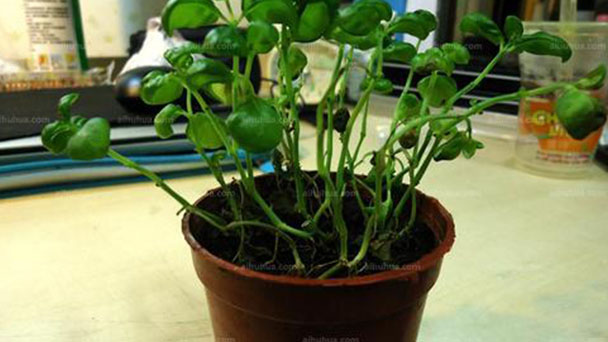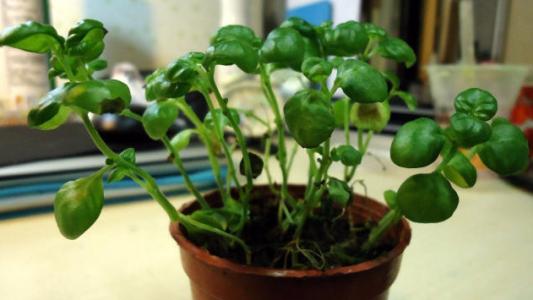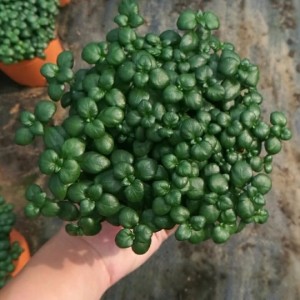Baby Tears Plant (Soleirolia Soleirolii) Profile
Written by Maggie
Oct 20 2021

Baby Tears Plant (Soleirolia Soleirolii) is a creeping perennial with small, bright green leaves, ideal for a pot flower background. In a frost-free climate, it remains green all year round.
Baby Tears Plant Picture
Baby Tears Plant Info
| Botanical Name | Soleirolia soleirolii |
| Common Names | Baby tears, Baby Tears Plant, angel's tears |
| Plant Type | Herbaceous perennial, often grown as an annual |
| Sun | Outdoors, part sun; indoors, bright filtered light |
| Hardiness Zones | 9 to 11 (USDA); grown as an annual elsewhere |
| Flower color | Creamy ivory |
| Native Area | Corsica, western Mediterranean |
| Mature size | 4 inches tall; spread of 36 inches or more |
Baby Tears Plant Characteristics
Baby Tears Plant Stems
Baby Tears Plant are perennial herbs with stolons. Stems are fleshy, slender, slightly enlarged in the middle, 25-70 cm high, 2-4 mm thick, glabrous, sparse pubescent on the upper part, densely streaked cystolith.
Baby Tears Plant Leaf
Baby Tears Plant leaf is paper, with the recent large, such as narrow ovate, lanceolate or ovate, oval 4-11 cm long, 1.5 4.5 cm wide, apex caudate acuminate or acuminate, base rounded, rare broadly cuneate, margin from the bottom to serrate, apex and light rare heavy blade, the dark green, glossy, light green, below the stalactite body bar, 0.5 0.6 mm long, the two sides, obviously, basal veins 3, its two arc curved side out, stretch up to the upper and lateral veins, lateral veins 8 and 13 pairs, slightly oblique exhibition show net vein; Petiole of Baby's tears is slender, 17 cm long, often glabrous, rare pubescent; Stipules are large, greenish, oblong, 8-12 mm long, glabrescent.
Baby Tears Plant Flowers
The baby tears plant flowers are dioecious; Male inflorescences cymes racemose, 2-5 cm long, with a few branches, cymbose clusters sparsely on flowering branches; Female cymes are shorter and denser. Male flowers are pedunculate or subsessile, ca. 1 mm in bud length; Tepals are greenish yellow, 4-lobed, ovate-oblong, apex acute, outside near apex with short hornlike protuberances; Baby's tears has 4 stamens, anthers white or pinkish, filaments and connective red; Pistils are small, conical.
Baby Tears Plant Fruit
Baby Tears Plant Achene is small, oval, skew tip, nearly 0.8 mm long, ripe green brown, there are obvious spiny small warts. Persistent perianth segments 3-lobed, equal-large, ovate-oblong, apex obtuse, ca. 1/3 as long as fruit. A few specimens of this species from zhejiang, fujian and sichuan, and a few specimens from eastern and southern sichuan, have short hairs on stems, petioles and back veins, which is a morphological change of this species.
Baby Tears Plant Habits
Baby 's tears in & gt;8.5 mu mol, m. - s. - 1 ~ 2 & lt; It can grow under the light condition of 299.0μmol·m-2·s-1(425 ~ 14 9501X, Rh33%-69%, temperature 15 ~ 25℃).
Baby Tears Plant Care
Baby Tears Plant Soil
A rich soil amended with humus, compost, or manure will increase the nutrients available to Baby Tears Plant plants, and will also help to regulate the moisture level for plants. Any commercial potting soil is suitable for growing baby tears as houseplants or in containers.
Baby Tears Plant Lighting
Baby Tears Plant is a beautiful leaf indoor flower, very shade tolerant, but love it more sufficient light, and should avoid strong direct light. Summer flowerpots are placed in the north window, and winter is placed in the south window. The light is too dark, the color of the leaves will fade; If the sun is too strong, the leaves will burn.
Baby Tears Plant Watering
Grasp the principle of wetting management, keep the basin soil dry but not cracked, moist but not wet is better. Spray water on your foliage regularly in the summer to keep Baby's tears clean and shiny. Keep the soil moist and do not apply fertilizer when the temperature is high. Winter foliage spray less water, otherwise the foliage will appear black spots, or even black rot. Growing period two weeks or so irrigate a 28 % or 37 % liquid nitrogen fertilizer to make the Baby's tears robust. After autumn, phosphorus and potash fertilizer is added to strengthen the stalks and prevent lodging.
Baby Tears Plant Trim
Baby Tears Plant resistant to pruning, cutting seedlings on the pot after the heart can be picked 1 times, when the new lateral branches grow to 4 leaves, and then leave 2 leaves to pick the heart, so repeated, can form a multi-branched full hemisphere spherical plant shape. Old Baby's tears growth over tall, can be in the spring for the pot to leave the base of 2 ~ 3 sections, heavy cut short, hair new branches after picking the heart 2 ~ 3 times, and can form a short and compact plant shape.
Baby Tears Plant Repotting
Growing Baby Tears Plant planted in containers is the best strategy for those living in cold climates, as well as those who live in areas where the plants are invasive outdoors. A commercial potting soil lightened with additional peat moss or perlite provides a healthy growing medium for plants.
Baby Tears Plant plants work well in a variety of container situations. In a small hanging basket, the spreading plants can spill attractively over the sides. In a terrarium, the plants can creep to the edges of the glass, hiding all bare soil. In a mixed outdoor planting, place baby tears plants at the edge of the container, in combination with mounding plants like impatiens and tall plants like coleus—plants that thrive in the same light and moisture conditions.
Baby Tears Plant plants grow quickly and need to be repotted regularly. Pot-bound plants are more susceptible to drying out, and you'll notice an increased occurrence of wilting in plants that need to be repotted. Because the stems are so fragile, you must not pull plants out of their containers by the stems or leaves. Turn the pots upside and tap them, squeeze them, or push on the drainage hole with a pencil to coax the plants loose. Repot with commercial potting soil, and water thoroughly. (Find more best indoor hanging plants here.)
Baby Tears Plant Temperature & humidity
As an outdoor specimen, the Baby Tears Plant plant grows best in temperatures of 50 to 70 degrees Fahrenheit. The higher the ambient temperature, the more attention the gardener must pay to light and humidity. Baby Tears Plant plants can tolerate a light frost, but freezing temperatures, as sometimes occur in hardiness zone 9, may kill the top growth of the plant. Be patient; it will come back from the roots in this transitional climate.
Baby Tears Plant plants appreciate a high humidity level. This makes them ideal for a steamy bathroom or kitchen. In drier environments, the plants appreciate the humid confines of a terrarium.

The Baby Tears Plant Propagation
The propagation of Baby Tears Plant is mainly carried out by cuttings in spring and autumn. In spring, the tip of the stem is used as a spike, and river sand or vermiculite is used as the medium. Roots will grow in about 10 days under appropriate temperature conditions (20℃ to 25℃). When the new buds have grown 3 to 5 centimeters, pot them with sandy soil. Pour enough fixed root water, into the normal management.
Baby Tears Plant Disease
Baby Tears Plant is a common leaf spot hazard, which can be prevented by spraying 200 times Bordeaux liquid. The basin soil is too wet, easy to produce root rot, and can be irrigated with 1000 times of Torbujin liquid. The nodular nematode was found, which could be controlled by 3% carbofuran. Have scale insect harm, use 40% oxidized diethoate 1000 times liquid spray kill. The beetle bites the leaf, can kill artificially or spray 1000 times liquid with trichlorfon.
Baby Tears Plant Varieties
The standard green species of Baby Tears Plant is most common in the trade. However, there are two color variants available, including 'Aurea' with golden foliage, and 'Variegata' with white stippling. The green color is dominant across all varieties, and you must prune away any green stems in the gold and variegated types to prevent them from reverting to solid green.
Baby Tears Plant Distribution
Baby Tears Plant is native to tropical to subtropical Corsica and Sardinia.
Baby Tears Plant was born in valleys, streams or wet places under the forest, at an altitude of 300-1500 meters. Produced in Guangdong, Guangxi, Hunan, Hubei, Guizhou, Sichuan, S Gansu, S Shaanxi, S Henan, S Anhui, Jiangxi, Zhejiang, Fujian and Taiwan.
Baby Tears Plant are distributed in Japan and Vietnam.
Used with all herbal medicines, Baby Tears Plant has the effect of clearing away heat, reducing dampness, activating fluid and quenching thirst, and repelling yellow and protecting the liver.
According to the Chinese Materia Medica, the medicinal nicknames of the flower include water hemp leaf (Sichuan), soil licorice, goat's blood, white goat, sweet grass, etc.May summer, autumn harvest, fresh use or drying.
Baby Tears Plant Uses
Baby Tears Plant is a popular small foliage plant grown for ornamental purposes. It has lovely green stems and can be used as ground cover. Shade-resistant, can be used as indoor greening materials. With the ability to absorb toxic substances, suitable for growing in newly decorated rooms. But the application is not as good as the same ornamental species flower leaf cold water flowers.
Baby Tears Plant are adaptable, easy to breed, easy to keep, small and elegant plant clusters, clear green and white leaves, beautiful patterns. The furnishings are elegant and pleasant in the study and bedroom. Baby 's tears also can be suspended at the window, green leaves hang down, charming and lovely. Inflorescences from leaf axils, pedicels light brown, translucent, top birth cyme, for people to watch.
Latest Updated
- Benefits of Bugleweed - 7 Science-backed Health Benefits
- Bugleweed Dangers & Side Effects - Is It Poisonous?
- How to Plant Evergreen Trees - What You Should Know
- When to Plant Evergreens - Grow Guide for Evergreen Trees
- 12 Wonderful Evergreen Shrubs for Your Garden
- 12 Popular Evergreen Plants with Pictures for Beginners
- When And How To Prune A Lilac Bush Like a Pro
- How to Grow & Care for Lilac Vine (Hardenbergia Violacea)
- Japanese Lilac Tree (Syringa Reticulata) Care & Propagation Guide
- Shumard Oak Pros and Cons - What to Know
Popular Articles
- Winter maintenance of Antirrhinum Majus
- How to Grow Terminalia Mantaly Tree
- How to Grow and Care for Crossostephium Chinense
- How to grow Antirrhinum Majus in spring
- Peristeria Elata (Dove Orchid) Profile: Info & Care Guide
- Underwatered Snake Plant (Sansevieria Trifasciata) - Signs And How To Fix
- How to Care for Brazilian Jasmine Plant (Mandevilla Sanderi)
- How to Grow & Care for Graptopetalum Purple Delight in Summer
- Rosa Chinensis (China Rose): Plant Growing & Care Tips
- How to Care for Baby Sun Rose (Aptenia Cordifolia)
